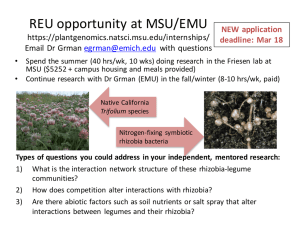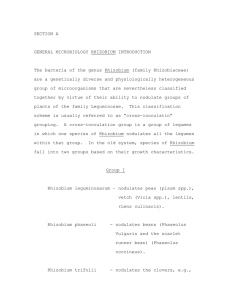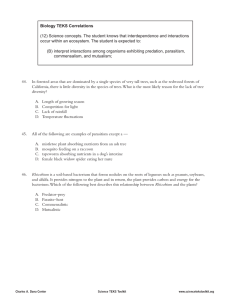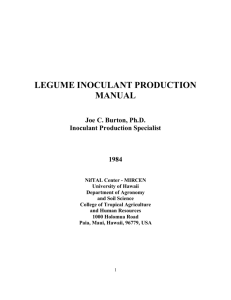The rhizobia were first characterized by their ability to induce... the roots of certain leguminous plants. These nodules often resulted... II. RHIZOBIA
advertisement
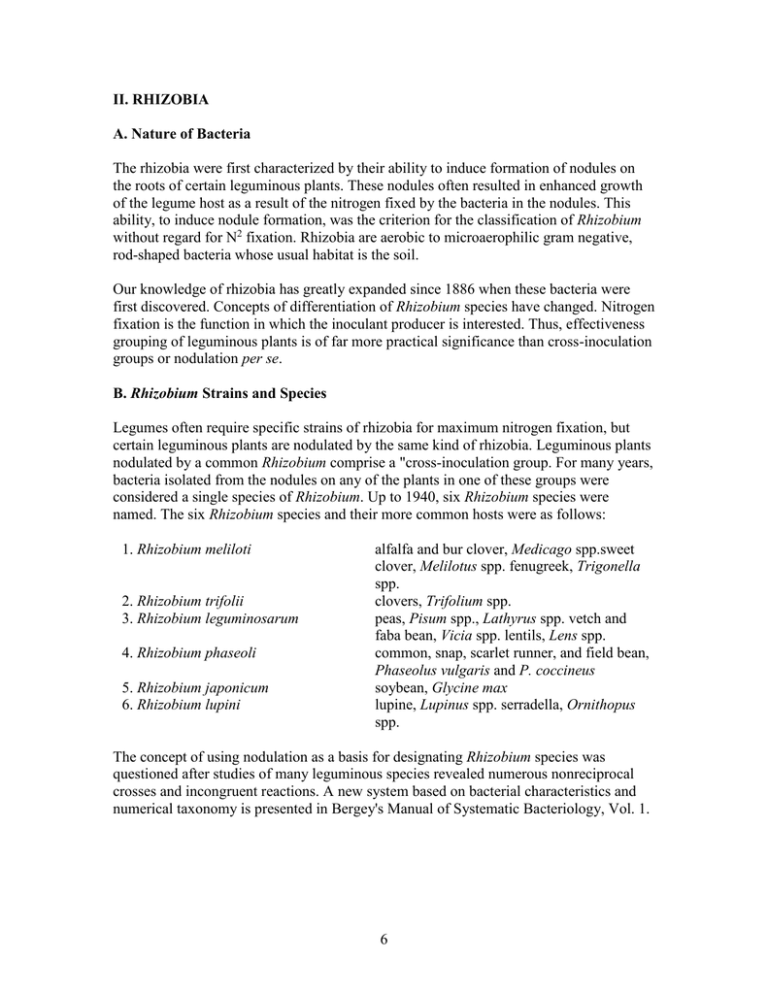
II. RHIZOBIA A. Nature of Bacteria The rhizobia were first characterized by their ability to induce formation of nodules on the roots of certain leguminous plants. These nodules often resulted in enhanced growth of the legume host as a result of the nitrogen fixed by the bacteria in the nodules. This ability, to induce nodule formation, was the criterion for the classification of Rhizobium without regard for N2 fixation. Rhizobia are aerobic to microaerophilic gram negative, rod-shaped bacteria whose usual habitat is the soil. Our knowledge of rhizobia has greatly expanded since 1886 when these bacteria were first discovered. Concepts of differentiation of Rhizobium species have changed. Nitrogen fixation is the function in which the inoculant producer is interested. Thus, effectiveness grouping of leguminous plants is of far more practical significance than cross-inoculation groups or nodulation per se. B. Rhizobium Strains and Species Legumes often require specific strains of rhizobia for maximum nitrogen fixation, but certain leguminous plants are nodulated by the same kind of rhizobia. Leguminous plants nodulated by a common Rhizobium comprise a "cross-inoculation group. For many years, bacteria isolated from the nodules on any of the plants in one of these groups were considered a single species of Rhizobium. Up to 1940, six Rhizobium species were named. The six Rhizobium species and their more common hosts were as follows: 1. Rhizobium meliloti 2. Rhizobium trifolii 3. Rhizobium leguminosarum 4. Rhizobium phaseoli 5. Rhizobium japonicum 6. Rhizobium lupini alfalfa and bur clover, Medicago spp.sweet clover, Melilotus spp. fenugreek, Trigonella spp. clovers, Trifolium spp. peas, Pisum spp., Lathyrus spp. vetch and faba bean, Vicia spp. lentils, Lens spp. common, snap, scarlet runner, and field bean, Phaseolus vulgaris and P. coccineus soybean, Glycine max lupine, Lupinus spp. serradella, Ornithopus spp. The concept of using nodulation as a basis for designating Rhizobium species was questioned after studies of many leguminous species revealed numerous nonreciprocal crosses and incongruent reactions. A new system based on bacterial characteristics and numerical taxonomy is presented in Bergey's Manual of Systematic Bacteriology, Vol. 1. 6 Fast-Growers R. meliloti Medicago spp., Melilotus spp., Trigonella spp. R. leguminosarum biovars: trifolii phaseoli viceae Trifolium spp. Phaseolus vulgaris, P. coccineus Pisum, Lathyrus, Lens, Vicia R. loti Lotus spp. (fast growers), Lupinus spp. R. japonicum Glycine max (certain Chinese and Asian isolates) Slow Growers Bradyrhizobium japonicum biovars: glycinae vignaea lupinea Glycine max Vigna - etc. Lupinus, Lotus pedunculatus The rhizobia isolated from cowpeas and numerous other legumes were not given species names until recently. These were simply identified by the name of their parent host. This system is still being used with many leguminous species. Up to now, only about 16% of the 18,000 leguminous species have been examined for nodulation (Allen and Allen, 1981) and many of the Rhizobium strains isolated have not been adequately characterized for growth characteristics or the range of hosts with which they are able to form a symbiosis. C. Fast and Slow Growers It is generally conceded that Rhizobium spp. fall into two distinct categories based on growth characteristics. Rhizobium meliloti, R. trifolii, R. phaseoli, R. leguminosarum and rhizobia isolated from nodules on sesbania, birdsfoot, chickpea, and others are considered "Fast Growers." When incubated at 28C on a solid medium such as yeast extract mannitol (YMA), visible colonies develop in 4 to 5 days. In contrast, the "Slow Growers", Bradyrhizobium japonicum and others, require 6 to 8 days to produce visible colonies when incubated under the same conditions. However, within these two general groups, strains of rhizobia vary in their growth rates in culture; the division into slowand fast-growers on the basis of time required to develop visible colonies is not absolute. D. Cultural Requirements Rhizobia are heterotrophic, aerobic to microaerophilic, gram negative, non-sporulating rods with a generation time of 3 to 8 hours. They will grow on the surface of solid media and also in static liquid media providing a large surface area is provided. Growth in submerged culture in fermentors with aeration is recommended for maximum viable cell production. The oxygen or aeration demands of rhizobia are not great. Five to ten liters of air per liter of medium per hour is adequate. Optimum growth occurs at 29 to 30C. 7 Rhizobia must be supplied with a source of energy, nitrogen, minerals and growth factors. Sucrose is the most commonly used carbon source for fast-growers because it is universally available, satisfactory and inexpensive. Mannitol and glycerol are preferred by some manufacturers. The slow-growing rhizobia are reported to prefer pentoses (and hexoses), such as arabinose or xylose. In submerged culture, growth obtained with sucrose is equal to that obtained with other sugars or glycerol. In culturing rhizobia, it should be remembered that the ability of these microorganisms to utilize particular carbohydrates depends to some extent upon the basal medium, the nitrogen source, the oxidation reduction potential, the method of sterilization, size of the inoculum used, and other factors. Most rhizobia are able to use ammonium or nitrate ions as a source of nitrogen, but growth is usually better in media which supply an adequate amount of low molecular weight amino acids such as occur in plant extracts, yeast, alfalfa, cabbage, wheat straw, corn steep liquor, hydrolyzed casein, and other substances. 8
